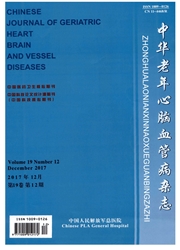

 中文摘要:
中文摘要:
目的探讨Wingspan支架治疗症状性颅内动脉狭窄的安全性、可行性和远期疗效。方法应用Wingspan支架治疗症状性颅内动脉狭窄患者16例,观察其手术成功率、手术前后狭窄率、症状改善及严重不良事件的发生情况。术后6个月行脑血管造影术观察支架内再狭窄发生率。结果患者术前平均狭窄率为(80.6±12.1)%,Wingspan支架置入后平均残余狭窄率为(20.4±10.2)%,手术成功率100%。30天和6个月内同侧脑卒中的发生率分别为6.3%和12.5%。68.8%患者症状改善明显。5例患者行脑血管造影术复查,1例伴有80%再狭窄。结论Wingspan支架治疗症状性颅内动脉狭窄成功率高,具有较好的安全性和临床疗效。
 英文摘要:
英文摘要:
Objective To investigate the safety, feasibility and long-term efficacy of the Wingspan stent in treatment of symptomatic intracranial arterial stenosis. Methods Treatment with Wingspan stent was attempted in 16 patients. The technical success rate,average stenosis before and after treatment,major complications and clinical outcome were observed. Conventional cerebral angiography was performed at 6 months after stenting. Results The average pretreatment stenosis was(80.6± 12.1)%. After Wingspan stent placement, the average stenosis was(20.4±10.2)%. The technical success rate was 100%. The rate of ipsilateral stroke within 30 days and 6 months was 6. 3% and 12. 5%, respectively. The symptoms were significantly improved in 68. 8% patients. Five patients underwent conventional cerebral angiography reexamination,in-stent stenosis was detected in one patient with 80 % restenosis. Conclusion Symptomatic intracranial artery stenosis can be treated with Wingspan stent with high rate of technical success,acceptable safety and clinic outcome.
 同期刊论文项目
同期刊论文项目
 同项目期刊论文
同项目期刊论文
 Decreasing radiation doses in digital subtraction angiographies consecutively performed by trainees.
Decreasing radiation doses in digital subtraction angiographies consecutively performed by trainees. Atorvastatin reduces plaque vulnerability in an atherosclerotic rabbit model by altering the 5-Lipox
Atorvastatin reduces plaque vulnerability in an atherosclerotic rabbit model by altering the 5-Lipox Decreased hyperintense vessels on FLAIR images after endovascular recanalization of symptomatic inte
Decreased hyperintense vessels on FLAIR images after endovascular recanalization of symptomatic inte Danshen extracts decrease blood C reactive protein and prevent ischemic stroke recurrence: A control
Danshen extracts decrease blood C reactive protein and prevent ischemic stroke recurrence: A control Successful recanalization of a chronic in-stent occlusion at the vertebral artery ostium A case repo
Successful recanalization of a chronic in-stent occlusion at the vertebral artery ostium A case repo Plasma C-reactive protein is related to cognitive deterioration and dementia in patients with mild c
Plasma C-reactive protein is related to cognitive deterioration and dementia in patients with mild c Hyperintense vessels on FLAIR: A useful non-invasive method for assessing intracerebral collaterals.
Hyperintense vessels on FLAIR: A useful non-invasive method for assessing intracerebral collaterals. 期刊信息
期刊信息
